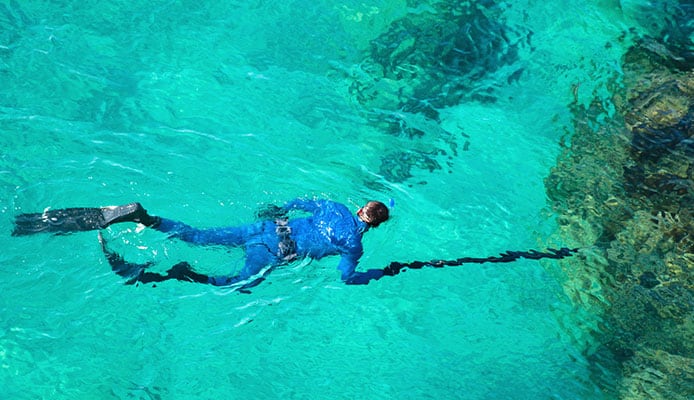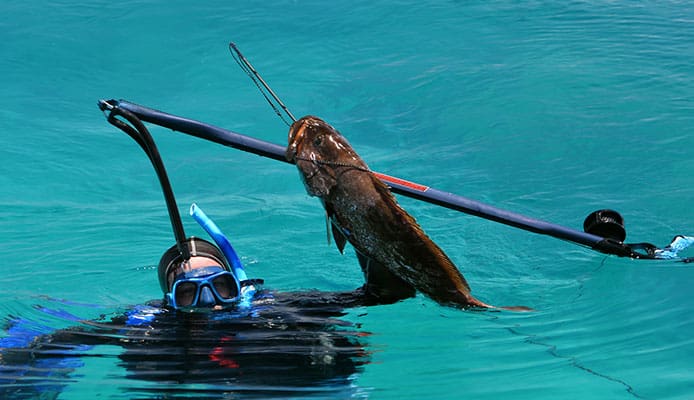
Spearfishing can be an enjoyable activity, but it is not always as easy as many seasoned spearfishermen or actors in movies make it appear. It will require you to have good diving skills and a good grasp of how to use your spearfishing tools and equipment. Fortunately, all these can be learned by undergoing spearfishing training. But what exactly do spearfishing lessons teach you, and what particular types of training do you need to undergo to become a successful spearfisherman?
Freediving and Spearfishing Training
Freediving and spearfishing training is actually pretty much the same, except of course for the actual hunting and spearfishing which will be missing from freediving training courses. However, the breath-holding, diving, and swimming techniques are basically similar. That said, if you’re just getting started with spearfishing, it is highly recommended that you start with learning freediving first. This will help you develop the requisite skills that will eventually help you learn spearfishing and meet its specific demands. Once you’ve got a good grasp of the fundamentals and technicalities of freediving, you can move on to taking specialized drills and skills for spearfishing.
When training for spearfishing, turn your focus to drills that mimic the actual conditions and scenarios that you will potentially encounter when hunting for fish in open waters. This includes learning how to move underwater as calmly as possible, stalking your prey, and others. You will also arrive at the point when you’ll have to train yourself to use your spearfishing equipment effectively, so may want to train with your spearfishing wetsuit, fins, and masks. Depending on the circumstances, you can do your freediving and spearfishing training in the pool or open waters, though as a beginner you may want to consider starting at the safety and confines of a swimming pool.
In Pool vs. Open Water Training
Most people would think that training for spearfishing means heading out to the ocean. Although training in the actual environment is definitely the best way to go, one should not ignore the benefits of training in the pool. This is especially true for those who are just getting started with deep diving.
In a pool, training can help beginners learn the basics of freediving while more advanced lessons can help to hone and improve previously learned diving skills. Even some experienced divers still attend pool training to detect flaws in their diving skills and techniques and fix them before heading back to the sea.
Training for spearfishing can take many forms, but for beginners, it is advisable to develop basic diving skills in the safety and confines of a swimming pool. As you progress with your diving skills, you can start thinking about transferring to the sea and applying all the techniques you’ve learned.
Holding Your Breath
Your first lesson should be learning how to hold your breath for an extended period while underwater. The longer you can hold your breath underwater, the longer you’ll be able to stay at the bottom which then means you have better chances of spotting and hunting the perfect fish to spear. Breath-holding is one of those techniques that can be learned and improved upon in the swimming pool.
Diving Deeper
Many of the greatest treasures for a spearfishermen lounge in the deeper parts of the water, making learning how to dive deeper an essential skill for any spearfisherman. Although you can dive deep on your own, using certain equipment like diving weight belts can help. The ability to dive deeper is greatly related to how long you can hold your breath, which again makes improving your breath-hold technique an important aspect of spearfishing.
An important concept to remember is to always equalize before you start with your dive. Many beginning spearfishermen and even divers often forget this advice, but it is crucial to ensure a good descent and avoid deep-diving injuries like barotraumas. You’ll also want to make sure that you follow the correct ascent and descent protocols to avoid the same injuries. You can use a freediving watch to monitor your diving progress as well. These watches can help you work out exactly how long you can stay underwater and even has alarms to alert you when it’s time to head back to the surface. This is important because many spearfishermen have lost track of their time underwater as they are too excited about catching their prey. When the alarm sounds, head back to the surface even if there’s a trophy-sized fish in the distance. There’s no point in spearing a large trophy if you blackout underwater water or on your way to the surface.
Swimming Underwater
When underwater, you’ll want to conserve as much oxygen and energy as possible. One technique to achieve this is by simply not moving around too much underwater. When you constantly move around, your body burns more energy and oxygen so it is always best to settle down and wait for your prey to come around. Besides, most fish are easily spooked and will swim away when they see something coming towards them. So instead of chasing your prey, lay low and wait for the fish to come to check you out. Many professional spearfishermen actually spend more time waiting for their prey than actually hunting for them. This helps them conserve oxygen since they don’t burn too much oxygen which happens when you keep kicking with your diving fins.
If you need to move around (as you most likely will if there are no fish to target within your range), you’ll want to consider using your arms instead of your legs. That is, use your arms to move around by grabbing at rocks instead of kicking with your legs. This helps you to conserve energy and oxygen and thus allows you to stay underwater for longer. You’ll also minimize the chances of your scaring the fish away with your big and abrupt movements.
Also, many seasoned spearfishermen keep their bodies flat while underwater. This helps trim down their profile which helps to minimize the effects of swells and currents. It also makes them less threatening to the fish in the area.
If you scared the fish into hiding, don’t think about chasing them in their hiding spots. More often than not, these hiding spots are too small and you won’t get any decent shot anyway. Instead, stay calm and wait for the fish to come out again as they eventually will.
Hunting Near the Surface
If you’re just getting started with spearfishing, it is highly recommended that you start your career by hunting near the water’s surface. In fact, this isn’t much of a recommendation but more of a requirement since spearfishing instructors won’t let you dive into deep waters unless you’ve gained enough experience and skill in spearfishing from the surface.
Some people get worried that they won’t catch anything near the surface, but many experienced spearfishing enthusiasts have actually caught much remarkable fish (both in species and size) this way. Also, as a beginner you’re focus shouldn’t be on catching a trophy-sized fish but rather on honing your skills at spearfishing. As you develop better breath-holding skills and become more adept at spotting your prey, you can start hunting in deeper waters.
The thing about spearfishing near the water’s surface is that you’ll be looking down on any fish you intend to spear. When you look down on a fish and aim, you’ll have a lesser area to target. Most of the time your only target will be the top side of the fish. This can make it difficult to hit the fish, but the pull of gravity as you throw your spear downwards can help accelerate it and hopefully hit the fish before it swims away.
You might also like: Top Spearfishing Spots In The World
Hunting in Deeper Waters
Hunting in deeper waters should only be attempted by those who have gained enough experience and the requisite skills for making deep dives. If you’ve met all those requirements, then by all means go ahead and start exploring the wondrous possibilities hidden in the deep.
There are certain things that every spearfisherman should understand about hunting in deeper waters. For one, it will take you a long time to descend and ascend, which can translate to lost time which you could’ve used hunting for your prey. Also, the deeper your dive the longer your surface recovery time should be. In general, your surface interval should be twice as long as your dive.
Also, as opposed to spearfishing near the surface where you’ll be looking down while hunting, you’ll be at the same level as the fish when you go deeper. This comes with the benefit that you’ll have a much bigger target to aim for. However, it also comes with a disadvantage when you’re using a spearfishing mask. This is because your mask will limit your vision to a certain degree, so you’ll need to move your head around to get a complete view of your environment.
Globo Surf Overview
Spearfishing can open up a whole new world for anyone who dares to try the sport. The excitement of the hunt in a world that is unlike what the human body is accustomed to is more than enough reason to entice anyone to engage in spearfishing. However, it does require a certain level of experience and set of skills to accomplish. If you are planning to be part of the growing community of spearfishing enthusiasts, start with taking freediving and spearfishing training. Those diving and spearfishing lessons you’ll learn will go a long way in helping you become a more successful spearfisherman in the long run.
More Scuba Reviews:
- BCD
- Dry Suit
- Gifts For Scuba Divers
- Air Integrated Dive Computer
- Dive Bags
- How Long Does A Scuba Tank Last
- Wetsuits Guide
- Skin Bends


